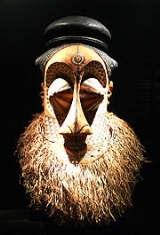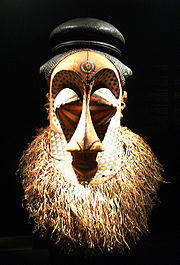
Kuba Kingdom
Encyclopedia
The Kuba Kingdom (1625–1900) was a pre-colonial Central African state bordered by the Sankuru
, Lulua, and Kasai
rivers in the southeast of what is today the Democratic Republic of the Congo
(formerly Zaire). The Kuba kingdom was a conglomerate of several smaller Bushongo-speaking principalities as well as the Kete
, Coofa, Mbeengi, and the Cwa Pygmies. The original Kuba migrated during the 16th century from the north.
kingdoms to the west. After learning all he could from these states, he returned to Kuba to form the empire's political, social and economic foundations.
and Ndongo kingdoms on the coast. Toward the end of the 19th century, the kingdom was invaded by the Nsapo people. The weakened Kingdom never recovered, and it was fragmented into chiefdoms once again by the time of the area became a Belgian colony
.
The current reigning monarch, Kot-a-Mbweeky III, has been on the throne since 1969.
 The Kuba are known for their raffia embroidered textiles, fiber and beaded hats, carved palm wine cups and cosmetic boxes, but they are most famous for their monumental helmet masks, featuring exquisite geometric patterns, stunning fabrics, seeds, beads and shells. They have been described as a people who cannot bear to leave a surface without ornament.
The Kuba are known for their raffia embroidered textiles, fiber and beaded hats, carved palm wine cups and cosmetic boxes, but they are most famous for their monumental helmet masks, featuring exquisite geometric patterns, stunning fabrics, seeds, beads and shells. They have been described as a people who cannot bear to leave a surface without ornament.
The boxes, known as Kuba Boxes and called ngedi mu ntey by the Kuba, are generally used to hold tukula powder and paste. The boxes are usually in the shape of a square with a faceted lid, a semicircle (sometimes referred to as "half moon"), a rectangle or the shape of a mask. Sometimes they were used for holding razors for cutting raffia, hairpins or ritual objects.
Tukula (called twool by the Kuba) is a red powder made of ground cam wood. The color red is essential to the Kuba concept of beauty and was therefore used to ornament the face, hair and chest during dances and important ceremonies, as well as to anoint bodies for burial. Tukula was also mixed with other pigments to dye raffia cloth.
After 1700, King Misha mi-Shyaang a-Mbul introduced wooden sculptures called ndop figures that were carved to resemble the king and represent his individual reign. These figures always included the king's ibol or personal symbol, akin to a personal standard.
The carved palm-wine drinking cups and ornately carved boxes are identified with competition between titled court members among the Kuba. With half of all Bushoong men holding titles in the 1880s, competition for influence was sometimes fierce, and it found expression in the elaboration of these essentially commonplace household objects into works of extraordinary beauty.
the Sky Father who spewed out the sun, moon, stars, and planets. He also created life with the Earth Mother. However these were somewhat distant deities, and the Kuba placed more immediate concern in a supernatural being named Woot, who named the animals and other things. The Kuba are sometimes known as the "Children of Woot."
Sankuru River
Sankuru River is a major river in the Democratic Republic of the Congo. Its approximate length of 1,230 km makes it the longest tributary of Kasai River....
, Lulua, and Kasai
Kasai River
The Kasai River is a tributary of the Congo River, located in central Africa. The river begins in Angola and serves as the border between Angola and the Democratic Republic of the Congo , then flows into the DRC, where it joins the Congo northeast of Kinshasa. The Kasai's tributaries include the...
rivers in the southeast of what is today the Democratic Republic of the Congo
Democratic Republic of the Congo
The Democratic Republic of the Congo is a state located in Central Africa. It is the second largest country in Africa by area and the eleventh largest in the world...
(formerly Zaire). The Kuba kingdom was a conglomerate of several smaller Bushongo-speaking principalities as well as the Kete
Kete
Kete can refer to:* afro-carib drums* a minor Kazakh Jüz "horde", numbering ca. 50-60,000* USS Kete * Kete, Pembrokeshire 51.69° N 05.18° W* Māori bags* Cocaine paste, a Peruanian slang name...
, Coofa, Mbeengi, and the Cwa Pygmies. The original Kuba migrated during the 16th century from the north.
Shyaam a-Mbul
The kingdom began as a conglomeration of several chiefdoms of various ethnic groups with no real central authority. In approximately 1625, an individual from outside the area known as Shyaam a-Mbul a Ngoong usurped the position of one of the area rulers and united all the chiefdoms under his leadership. Tradition states that Shyaam a-Mbul was the adopted son of a Kuba queen. He left the Kuba region to find enlightenment in the Pende and KongoKingdom of Kongo
The Kingdom of Kongo was an African kingdom located in west central Africa in what are now northern Angola, Cabinda, the Republic of the Congo, and the western portion of the Democratic Republic of the Congo...
kingdoms to the west. After learning all he could from these states, he returned to Kuba to form the empire's political, social and economic foundations.
A new government
The Kuba government was reorganized toward a merit-based title system, but power still remained firmly in the hands of the aristocracy. The Kuba government was controlled by a king called the nyim who beloned to the Bushoong clan. The king was responsible to a court council of all the Kuba subgroups, who were represented equally before the king by their elites.Growth
As the kingdom matured, it benefited from advanced techniques adopted from neighboring peoples as well as New World crops introduced from the Americas, such as maize, tobacco, cassava and beans. Kuba became very wealthy, which resulted in great artistic works commissioned by the Kuba nobility. The Kuba kings retained the most fanciful works for court ceremony and were also buried with these artifacts.Apex and decline
The Kuba Kingdom reached its apex during the mid 19th century. Europeans first reached the area in 1884. Because of the kingdom's relative isolation, it was not as affected by the slave trade as were the KongoKingdom of Kongo
The Kingdom of Kongo was an African kingdom located in west central Africa in what are now northern Angola, Cabinda, the Republic of the Congo, and the western portion of the Democratic Republic of the Congo...
and Ndongo kingdoms on the coast. Toward the end of the 19th century, the kingdom was invaded by the Nsapo people. The weakened Kingdom never recovered, and it was fragmented into chiefdoms once again by the time of the area became a Belgian colony
Belgian colonial empire
The Belgian colonial empire consisted of three colonies possessed by Belgium between 1901 and 1962: Belgian Congo , Rwanda and Burundi...
.
The current reigning monarch, Kot-a-Mbweeky III, has been on the throne since 1969.
Kuba art

The boxes, known as Kuba Boxes and called ngedi mu ntey by the Kuba, are generally used to hold tukula powder and paste. The boxes are usually in the shape of a square with a faceted lid, a semicircle (sometimes referred to as "half moon"), a rectangle or the shape of a mask. Sometimes they were used for holding razors for cutting raffia, hairpins or ritual objects.
Tukula (called twool by the Kuba) is a red powder made of ground cam wood. The color red is essential to the Kuba concept of beauty and was therefore used to ornament the face, hair and chest during dances and important ceremonies, as well as to anoint bodies for burial. Tukula was also mixed with other pigments to dye raffia cloth.
After 1700, King Misha mi-Shyaang a-Mbul introduced wooden sculptures called ndop figures that were carved to resemble the king and represent his individual reign. These figures always included the king's ibol or personal symbol, akin to a personal standard.
The carved palm-wine drinking cups and ornately carved boxes are identified with competition between titled court members among the Kuba. With half of all Bushoong men holding titles in the 1880s, competition for influence was sometimes fierce, and it found expression in the elaboration of these essentially commonplace household objects into works of extraordinary beauty.
Kuba religion and mythos
The Kuba believed in BumbaBumba
Bumba can refer to:*Bumba, Democratic Republic of the Congo, a town on the Congo River.*Bumba , a crater on Rhea.*Bumba , the supreme deity of the Bushongo people.*Bumba , a free slave group which controlled an enclave of Cuba....
the Sky Father who spewed out the sun, moon, stars, and planets. He also created life with the Earth Mother. However these were somewhat distant deities, and the Kuba placed more immediate concern in a supernatural being named Woot, who named the animals and other things. The Kuba are sometimes known as the "Children of Woot."
Further reading
- Jan Vansina. Being Colonized: The Kuba Experience in Rural Congo, 1880-1960 (University of Wisconsin Press; 2010) 342 pages; combines history and anthropology in a study of Belgium's colonization of the Kuba Kingdom.

